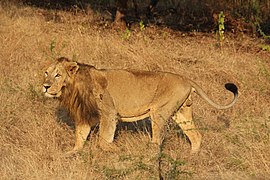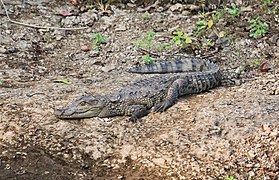Khathiar–Gir dry deciduous forests
| Khathiar–Gir dry deciduous forests | |
|---|---|
Northwestern thorn scrub forests | |
| Geography | |
| Area | 265,995 km2 (102,701 sq mi) |
| Country | India |
| states | |
| Coordinates | 24°48′N 75°48′E / 24.8°N 75.8°E[1] |
| Conservation | |
| Conservation status | critical/endangered |
| Protected | 11,335 km² (4%)[2] |
The Khathiar–Gir dry deciduous forests (also Kathiarbar-Gir or Kathiawar-Gir) is a mostly
Landscape

The Khathiar–Gir dry deciduous forests include the
The ecoregion has a
Flora

The composition of the ecoregion's forests varies with moisture and soil. They have a three-storied structure, with the top story reaching 15 to 25 m (49 to 82 ft). Arid areas are dominated by
Fauna
- endangered great Indian bustard (Ardeotis nigriceps)
- lesser florican (Eupodotis indica)
- near-endemic white-naped tit (Parus nuchalis), which inhabits the thorny scrub areas of the ecoregion.
The protected areas of this region are also home to 80 mammal species including[3]
- Indian leopard (Panthera pardus fusca), Indian wolf (Canis lupus pallipes), striped hyena (Hyaena hyaena), four-horned antelope (Tetracerus quadricornis), blackbuck (Antilope cervicapra), and chinkara (Gazella bennettii)
- jungle cat (Felis chaus), Asiatic wildcat (Felis silvestris ornata) and rusty-spotted cat (Prionailurus rubiginosus).[4]
- golden jackal (Canis aureus)[5]
- Bengal tiger (Panthera tigris tigris) in the eastern part of this ecoregion[6]
- Asiatic lion (Panthera leo leo) in Gir National Park and surrounding areas in Kathiawar Peninsula[7]
- Sloth bear (Melursus ursinus) in Ratan Mahal Wildlife Sanctuary[8]
-
Bengal tiger in Ranthambore National Park, Rajasthan
-
Male Asiatic lion in Gir Forest National Park, Gujarat
-
Indian leopard at Gir
-
Striped hyena
-
Golden jackal in the area of Rajkot
-
An Indian sloth bear walking on the road in Ratan Mahal Sloth Bear Sanctuary
-
Mugger crocodile at Gir
-
Great Indian bustard at the Naliya grasslands,Kutch
-
White-naped tit foraging on Prosopis juliflora at Kutch
-
A female lesser florican in flight from Rajasthan
Threats to biodiversity
The human population in the region is growing, and wildlife habitats have mostly been removed or degraded due to collection of firewood and timber, and use as grazing land for livestock.[citation needed]
Protected areas
Protected areas cover 8,980 km2 (3,470 sq mi) in this ecoregion, and include:[3]
- Balaram Ambaji Wildlife Sanctuary
- Jawahar Sagar Wildlife Sanctuary and National Chambal Sanctuary)
- Gandhi Sagar Sanctuary
- Ghatigaon Wildlife Sanctuary
- Gir Forest National Park
- Jaisamand Wildlife Sanctuary
- Jambughoda Wildlife Sanctuary
- Kumbhalgarh Wildlife Sanctuary
- Kuno National Park
- Madhav National Park
- Mount Abu Wildlife Sanctuary
- Nahargarh Biological Park
- Ramgarh Wildlife Sanctuary
- Ranthambore National Park
- Ratan Mahal Wildlife Sanctuary
- Sailana Kharmour Bird Sanctuary
- Sariska Tiger Reserve
- Sita Mata Wildlife Sanctuary
See also
- Ecoregions of India
References
- ^ World Database on Protected Areas (2019). "Darrah in India". Protected Planet United Nations Environment World Conservation Monitoring Centre.[permanent dead link]
- ^ Eric Dinerstein, David Olson, et al. (2017). An Ecoregion-Based Approach to Protecting Half the Terrestrial Realm, BioScience, Volume 67, Issue 6, June 2017, Pages 534–545; Supplemental material 2 table S1b. [1]
- ^ a b c d e f "Khathiar-Gir Dry Deciduous Forests". Terrestrial Ecoregions. World Wildlife Fund. Retrieved 14 February 2017.
- ^ Pathak, B. J. (1990). "Rusty-spotted Cat Felis rubiginosa Geoffroy: a new record for Gir Wildlife Sanctuary and National Park". Journal of the Bombay Natural History Society (87): 8.
- .
- ^ Jhala, Y. V.; Qureshi, Q.; Sinha, P. R., eds. (2011). Status of tigers, co-predators and prey in India, 2010. TR 2011/003 pp-302 (PDF). New Delhi, Dehradun: National Tiger Conservation Authority, Govt. of India, and Wildlife Institute of India. Archived from the original (PDF) on 20 January 2012.
- .
- ^ Garshelis, D. L.; Joshi, A. R.; Smith, J. L. D. & Rice, C. G. "Sloth Bear Conservation Action Plan". Bears: status survey and conservation action plan (PDF). Gland: IUCN. pp. 225–240. Archived from the original (PDF) on 23 July 2011. Retrieved 18 April 2011.
External links
- "Khathiar-Gir dry deciduous forests". Terrestrial Ecoregions. World Wildlife Fund.










